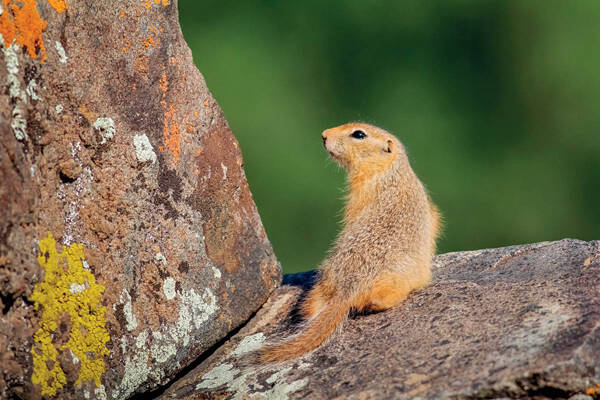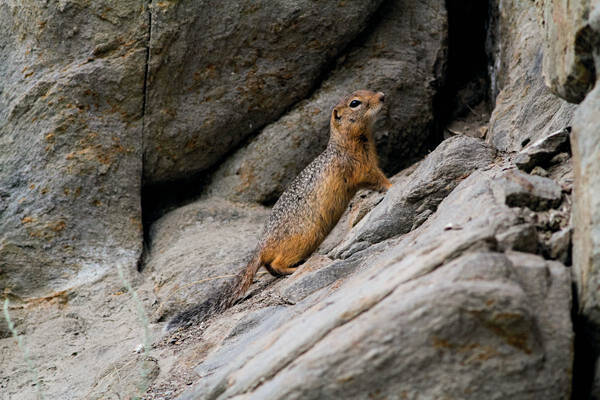Spermophilus undulatus
IUCN
LCBasic Information
Scientific classification
- name:Spermophilus undulatus
- Scientific Name:Spermophilus undulatus,Long-tailed Ground Squirrel,Bean rat, big-eyed thief
- Outline:Rodents
- Family:Rodentia Sciuridae Squirrel
Vital signs
- length:About 250-300 mm
- Weight:
- lifetime:
Feature
The long-tailed yellow squirrel is large in size, with the longest tail and largest body in the genus Yellow squirrel. It has long black claws, short ears, gray-brown back in summer, and its belly is mostly brown or rusty brown.
Distribution and Habitat
In China, it is distributed in Xinjiang, Inner Mongolia and Heilongjiang. Abroad, it is distributed in Russia, Kazakhstan and Mongolia.
It mainly inhabits the savannah area on the edge of the Gobi Desert, the alpine meadows and the shrubbery environment in the valley area.
Appearance
The tail is relatively long, equal to or greater than half the body length. The width between the orbits exceeds the length of the upper cheek teeth. In summer, the back of the body from the neck to the base of the tail is a mixed color of black and gray, and the middle of the back is darker. The area around the eye sockets is white with light yellow. The head, neck, sides of the body, front and back limbs and feet are all bright brown-yellow. The lips and chin are white; the throat and abdomen are brown-yellow. The inside of the limbs are white. The fur color on the upper part of the tail base is similar to the back of the body, the center of the tail tip is black, and the surrounding is white. In winter, the fur color is light, and the sides and belly of the body turn white.
Details
The long-tailed yellow squirrel is an animal of the Sciuridae family and the genus Squirrel. It mainly inhabits high mountains at 1700-3000m and relatively humid piedmont hills, forest edges and river valleys. The vegetation types are mostly mountain grasslands, forest grasslands and subalpine meadows. Generally, it chooses gentle slopes and river valleys with good vegetation growth as its habitat. Although it inhabits farmlands below the forest edge of hillsides with exposed gravel by the river, the number is small. Sometimes it can be seen in low mountain and hilly areas, but it is difficult to see in the Gobi Desert.

The long-tailed yellow rat is a daytime rodent, and its activity time varies with the seasons. In April and May, the weather is cold, and it often comes out to move between 8:00 and 14:00. After June, the weather turns warmer, and the activity time is also advanced. It often starts to move on the ground around 6:30, stops when it is hot at noon, and comes out of the hole again when it is cooler in the afternoon, and has a peak activity before sunset. In September, due to the low temperature, the activity time is postponed to around 8:00. Wind and rain have a certain impact on its activities. When active, they often stand on their hind legs and observe the surrounding movements. Sometimes they lie on the ground or bask in the sun on their white heads. When they encounter an enemy, they make a unique call to warn their kind and quickly flee back to the cave or hide in the grass.

The long-tailed yellow squirrel also has the habit of hibernation. They begin to come out of hibernation in late March to early April, and the order of coming out of hibernation is first the young mice and then the adult mice, regardless of gender. During the hibernation period, if there is a short-term sudden change in weather, it will not cause the hibernation to be interrupted. All hibernation is completed from mid-September to early October. The order of hibernation is female first, male second, and young mice last.
The caves of long-tailed yellow rats are generally distributed in higher places, and sometimes the gaps between piles of rocks are used as caves. Like other yellow rats, there are living caves and temporary caves. The living caves are curved, with main caves and branch caves inside, and there are blind caves near the nests to store feces. Sometimes the abandoned caves of marmots are used. Most of them have only one hole, and some have two. The diameter of the hole is 8-13cm, and the hole is often piled with broken soil. The length of the hole and the number of cave branches are related to the terrain, soil quality and other conditions. There is usually one nest, but occasionally there are two or more. The nest is oval
(26cm×22cm×20cm), covered with soft hay. The living hole in summer is shallow, and the hibernation hole is deeper, both below the permafrost layer. The temporary hole is relatively simple, without a nest, and is only used to escape from enemies.

After the long-tailed yellow squirrel comes out of hibernation in spring, it mostly feeds on dry grass. After the grass turns green again, it mainly feeds on the green parts of sedge and grass plants, and also eats some coleoptera insects. Under natural conditions, the long-tailed yellow squirrel refuses to eat all artificial baits, grains, grass, etc. In agricultural areas, it often steals crops and has the habit of storing food.
Long-tailed yellow rats reproduce once a year. After coming out of hibernation in spring, they begin to estrus and mate. The pregnancy rate is 85%. The gestation period is about 30 days, and the birth is concentrated in late May to early June. Generally, 7-8 pups are born, and up to 11 pups can be born. The lactation period is about 25 days, and the young mice begin to move on the ground in large numbers in late June. When the young mice can live independently, the mother mouse leaves the breeding nest to find a new home, and the young mice also leave the mother mouse cave after 4-5 days and find new homes. The young mice reach sexual maturity in the spring of the second year.

The population density of long-tailed yellow squirrels in the Tianshan Mountains of China is relatively high, with 10-50 per hectare in the Jinghe Mountains, 8-30 per hectare around Sayram Lake, 5-20 per hectare in the Bayinbuluke intermountain basin, and 2-7 per hectare in the Alatau Mountains. The density of long-tailed yellow squirrels in the Altai Mountains is much lower than that in the Tianshan Mountains, with 1-5 per hectare.








